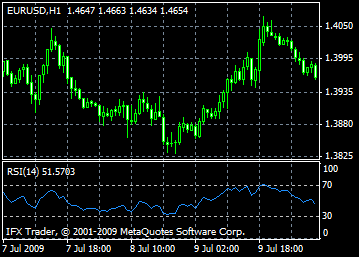The Relative Strength Index Technical Indicator (RSI) is a price-following oscillator which ranges from 0 to 100. RSI was created by Wilder, he recommended to use a 14-day RSI. As time goes by the 9-day and 25-day Relative Strength Index indicators have also gained popularity. One of the popular methods of the RSI analysis is to look for a divergence in which the price forms a new high and the RSI is failing to surpass its previous high. This divergence is an indication of the soon reversal. If the Relative Strength Index turns down and falls below its most recent trough, it means that the RSI indicator has completed a "failure swing". The failure swing is a confirmation of the impending reversal.
The following Relative Strength Indexes are distinguished:
Tops and bottoms The Relative Strength Index is usually formed above 70 and below 30. They usually advance tops and bottoms formation in the price chart;
Chart Models The RSI often forms chart patterns such as head and shoulders or triangles that may or may not be visible on the price chart;
Failure swing ( Support or Resistance penetrations or breakouts) This is where the Relative Strength Index surpasses a previous high (peak) or falls below a recent low (trough);
Support and Resistance levels Levels of support and resistance are better seen at the chat of the Relative Strength Index then at the price chat.
Divergences Divergences occur when the price makes a new high (or low) but it is not confirmed by a new high (or low) in the Relative Strength Index chat. Prices usually correct and move in the direction of the RSI.

RSI Calculation
RSI = 100-(100/(1+U/D))
Where:
U - is the average number of positive price changes;
D - is the average number of negative price changes.

The InstaForex Analyst Team
GK InstaFintech © 2007-2025















